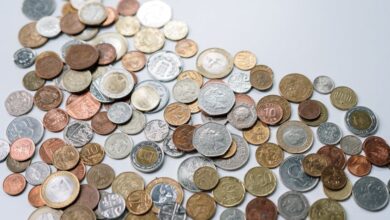Metals in Focus: Analyzing Silver, Copper, and the Evolving Landscape of Investment and Industry

In an increasingly interconnected global economy, the dynamics of metal markets play a pivotal role in shaping both industrial practices and investment strategies. This article delves into the multifaceted landscape of metals, highlighting their significance not only as essential components in manufacturing and technology but also as valuable assets in investment portfolios. With a focus on silver's dual utility, copper's reflection of economic health, and the burgeoning demand for rare earth metals driven by green energy technologies, we aim to illuminate the intricate relationships that govern these markets. Additionally, we will explore the investment potential of platinum and palladium, the effects of inflation on metal prices, and the future of aluminum in sustainable practices, while considering how mining regulations impact overall market trends. Join us as we navigate these critical topics, offering insights that are essential for investors and industry stakeholders alike.
- 1. **Navigating the Dual Landscape: Silver's Industrial Utility and Investment Appeal**
- 2. **Copper's Economic Barometer: Understanding Price Trends and Global Indicators**
1. **Navigating the Dual Landscape: Silver's Industrial Utility and Investment Appeal**
Silver occupies a unique position in both industrial and investment markets, making it a fascinating metal to analyze. Its dual role stems from its remarkable properties, which allow it to function effectively in various applications, while also serving as a store of value.
In the industrial sector, silver is prized for its exceptional electrical and thermal conductivity, making it essential in electronics, solar panels, and electrical contacts. Its antimicrobial properties also find applications in healthcare, where it is used in wound dressings and coatings to prevent infection. As industries increasingly adopt green technologies, such as solar energy, the demand for silver is expected to rise significantly. This industrial utility not only drives consumption but also creates a stable base for its market price.
On the investment side, silver is often viewed as a safe haven asset, similar to gold. Investors turn to silver during economic uncertainty, seeking to hedge against inflation and currency fluctuations. Its relatively lower price compared to gold makes it more accessible for individual investors, further enhancing its appeal. Additionally, silver's role in exchange-traded funds (ETFs) and physical silver bullion markets has expanded its attractiveness as an investment vehicle.
The interplay between silver's industrial demand and its investment appeal creates a complex market dynamic. Economic growth typically boosts industrial consumption, which can lead to price increases that benefit investors. Conversely, during economic downturns, while industrial demand may wane, silver's status as a safe haven can sustain its value.
In summary, silver's dual landscape as both an industrial commodity and an investment asset positions it as a versatile player in the market. Understanding this duality is crucial for investors and industry stakeholders alike, as it influences pricing trends and market strategies.
Silver plays a dual role in both industrial and investment markets, making it a unique asset among precious metals. In the industrial sector, silver is valued for its high conductivity, thermal properties, and antimicrobial qualities, which make it essential in electronics, solar panels, and medical applications. As industries continue to innovate and adopt advanced technologies, the demand for silver in manufacturing processes is expected to grow, especially with the rise of renewable energy solutions and electric vehicles.
In the investment realm, silver is often viewed as a safe-haven asset, similar to gold. Investors turn to silver during economic uncertainty or inflationary periods, as it tends to retain value over time. Its lower price point compared to gold makes it more accessible to a broader range of investors, further solidifying its role as a staple in diversified investment portfolios. The interplay between industrial demand and investment interest creates a dynamic market, influencing silver prices and availability.
Copper prices are a barometer of global economic health, reflecting demand from various sectors, particularly construction and manufacturing. As a critical component in electrical wiring, plumbing, and renewable energy technologies, fluctuations in copper prices can indicate changes in economic activity. A rising copper price often signals increased industrial output and infrastructure development, while declining prices may suggest a slowdown in growth and reduced demand.
The increasing focus on green energy technologies is significantly impacting the demand for rare earth metals. These metals are essential for producing high-performance magnets, batteries, and other components used in electric vehicles and renewable energy systems. As the world shifts towards sustainable energy solutions, the market for rare earth metals is likely to expand, leading to potential supply challenges and price volatility.
When comparing platinum and palladium as investment options, both metals have unique characteristics that appeal to different types of investors. Historically, platinum has been viewed as a more prestigious metal with a higher price point, often used in jewelry and catalytic converters. However, palladium has gained prominence due to its essential role in gasoline engine catalytic converters and has seen a surge in demand, driving prices higher. Investors must consider market trends, supply constraints, and their investment strategies when choosing between these two metals.
In the context of inflation, the prices of precious and industrial metals often rise as investors seek tangible assets to hedge against currency devaluation. Precious metals, such as gold and silver, tend to be favored during inflationary periods due to their intrinsic value. Meanwhile, industrial metals may also see price increases as production costs rise and demand remains strong.
Aluminum's future in a sustainable economy looks promising, particularly as industries seek lighter, stronger materials to improve energy efficiency. Its recyclability and lightweight properties position aluminum as a key material in sectors like automotive and aerospace, which are increasingly focused on reducing carbon footprints. As demand for sustainable practices grows, aluminum is likely to play a critical role in supporting a circular economy.
Lastly, mining regulations significantly impact metal prices. Stricter environmental regulations can lead to increased costs for mining companies, which may reduce supply and drive prices higher. Conversely, relaxed regulations can boost production but may raise concerns about environmental sustainability. The balance between regulatory frameworks and market demand will continue to shape the landscape of metal prices and the overall health of the mining industry.
2. **Copper's Economic Barometer: Understanding Price Trends and Global Indicators**
Copper is often referred to as "Dr. Copper" due to its ability to serve as a reliable indicator of global economic health. This reputation stems from the metal's extensive use in various industries, including construction, electronics, and transportation. As a result, fluctuations in copper prices can offer insights into broader economic trends.
Historically, rising copper prices have signaled increased industrial activity and economic expansion. When demand for copper surges, it typically indicates that businesses are investing in infrastructure and production, anticipating future growth. Conversely, declining copper prices may suggest a slowdown in economic activity, as lower demand from manufacturers and builders reflects waning confidence in the market.
Several key factors influence copper prices, including supply chain dynamics, geopolitical events, and global economic policies. For instance, disruptions in major copper-producing countries, such as Chile and Peru, can lead to supply shortages, driving prices higher. Additionally, trade policies and tariffs can impact the cost of raw materials, further affecting market trends.
Moreover, the correlation between copper prices and macroeconomic indicators, such as manufacturing indices and GDP growth rates, underscores its role as an economic bellwether. Analysts often track these indicators alongside copper prices to gauge the health of the global economy. For example, an increase in the Purchasing Managers' Index (PMI) often coincides with rising copper prices, as it signals increased manufacturing activity and demand for the metal.
In recent years, the transition to green energy technologies has also influenced copper demand. As industries shift toward renewable energy sources and electric vehicles, the need for copper in wiring, batteries, and infrastructure is expected to grow, potentially driving prices upward. This trend further solidifies copper's status as a key economic barometer, reflecting not only current market conditions but also future economic trajectories.
In summary, copper prices serve as a significant indicator of global economic health, shaped by a complex interplay of demand, supply, and macroeconomic factors. Stakeholders in both industrial and investment sectors closely monitor these trends to make informed decisions and anticipate shifts in the economic landscape.
In conclusion, the intricate dynamics of metal markets reveal a multifaceted landscape where industrial applications and investment opportunities intersect. Silver's unique position as both a critical component in various industries and a sought-after asset for investors underscores its significance in today’s economy. Similarly, copper serves as a vital economic indicator, reflecting global health and influencing market sentiments.
The rising demand for rare earth metals, driven by the shift towards green energy technologies, highlights the urgent need for sustainable practices and responsible sourcing in the mining sector. Meanwhile, the ongoing debate between platinum and palladium investments emphasizes the necessity for investors to carefully consider market trends and their respective advantages.
As inflation continues to shape the financial landscape, understanding its impact on both precious and industrial metal prices becomes increasingly important for portfolio diversification. Finally, the future of aluminum, coupled with evolving mining regulations, suggests a transformative pathway towards a more sustainable economy, where the balance between resource extraction and environmental responsibility will be pivotal.
Overall, the interplay of these factors not only influences market dynamics but also offers valuable insights for investors looking to navigate the complexities of metal investments in an ever-changing world. As we move forward, staying informed and adaptable will be key to capitalizing on the opportunities presented by this vital sector.





